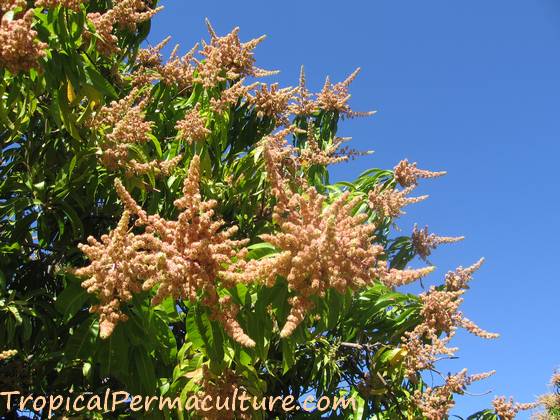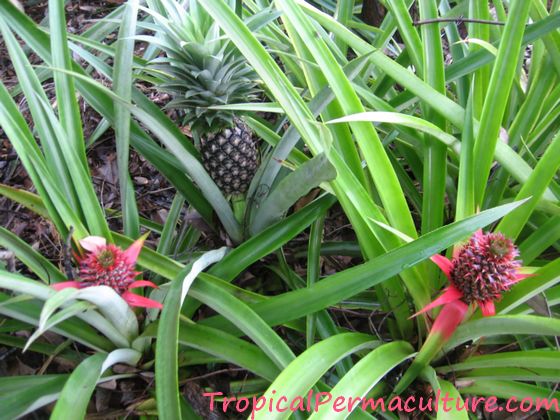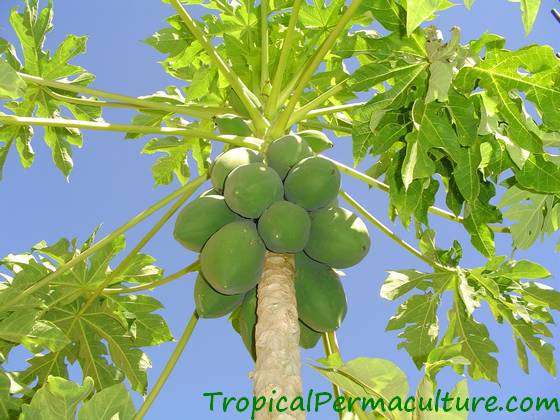Growing Passionfruit Vines
(Passiflora Edulis And Passiflora Edulis F. Flavicarpa)
Growing passionfruit is too difficult here, they told me. The climate is too harsh, the soil is too poor, the termites will eat them, a wilt disease or the nematodes will get them...
That was disheartening, because in most of Australia passionfruit is dead easy to grow.
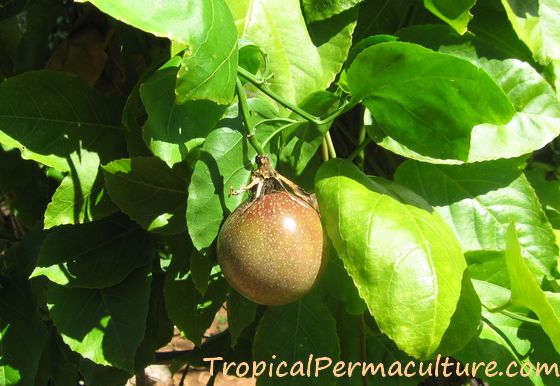
I have to admit that my climate and soil do present extreme challenges. I usually say, "If I can grow it, anybody can!"
Well, I did eventually work out how to successfully grow passionfruit, even here. Very successfully! Passionfruit is one of the fruits that I give away by the shopping bag full. My kitchen bench is always full of them when they are in season, my fridge is full, the freezer is full of pulp, and I still eat last year's when next year's crop starts.
I do have a little secret to growing passionfruit so successfully, beyond the growing methods that I explain below. I share that secret on the page where I talk about passionfruit in permaculture designs.
How To Grow Passionfruit Vines
What Is Passionfruit? What Do Passionfruit Vines Look Like?
I've been asked about growing passionfruit trees. Well, you already know it from my headline, the passionfruit is a climbing vine. More precisely, it is a very vigorous and fast growing climbing vine.
Passionfruit vines have large, three lobed leaves, little tendrils that wrap themselves around whatever they can get hold of, and the most gorgeous flowers of all fruits in my garden. (Ok, after pineapples.)
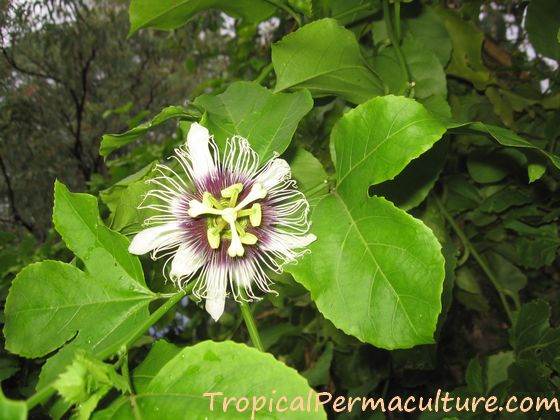
The fruit is either yellow or purple (depending on the variety, see below), round, and about 5-8 cm/2-3 inches across. It has a smooth, thick, pithy rind, filled with sweet, aromatic pulp, juice and seeds.
Passionfruit vines climb up any support, readily and rapidly, and they climb as high as the support will allow.
Passionfruit Varieties, Tropical Passionfruit
There are two main passionfruit varieties.
(Plus a bunch of lesser known passionfruits and related granadillas.)
Passiflora edulis is the purple passionfruit.
Passiflora edulis f. flavicarpa is the golden passionfruit, also called tropical passionfruit.
The purple passionfruit is a native of Brazil and is the sweeter of the two.
Nobody knows where the tropical passionfruit originated. The tropical passionfruit is slightly bigger and slightly more acidic.
Commercial growers in cooler climates often use hybrid varieties of the purple and golden passionfruit. That way they get a plant with large fruit that tolerates cooler weather.
The hybrids have all kinds of fancy names, SuperSweet, Lacey, Purple Gold etc.
The variety Panama confuses people, because it can be purple. However, Panama is a true tropical passionfruit of the type flavicarpa (which is usually golden). It is also called purple flavicarpa or Panama Red. Even though it seems to be a mix, it is not a hybrid!
If you live in a truly tropical climate you are obviously best of with a flavicarpa variety. They don't call them tropical passionfruit for no reason.
In a climate with cooler winters you want a purple passionfruit (P. edulis) or even a hybrid cultivar.
My climate is tropical and I grow the tropical kind, both golden and purple flavicarpa (i.e. Panama red).
What Do Passionfruits Like And Dislike?
Like all fast growing plants passionfruit needs a lot of nutrients. That lush green foliage has to come from somewhere, it can not materialise out of nothing. So passionfruit vines need fertile soils, probably additional fertiliser, and they appreciate all the compost and mulch you can spare.
They also need full sun, a warm climate, and protection from wind. A sunny, sheltered site in a frost free climate is ideal. There are some purple varieties that can handle the odd very light frost. And sometimes, even though the top of a vine is killed by frost, the roots reshoot. However, the warmer the climate, the easier it is to grow passionfruit.
Passionfruit need something to climb over. A fence, a water tank, a trellis, anything will do. Watch where you plant them, because they will be up in the crown of a nearby tree before you know...
Passionfruit plants have a vulnerable root system. A healthy soil, teeming with worms and microbes and lots of organic matter is your best bet. If your soil is poor you will get problems with wilt diseases, root rot and nematodes. Heavy clay soils also cause problems with rot diseases.
Watering: The root system of a passionfruit vine is small for the size of the plant it has to sustain. Especially while a passionfruit is fruiting it needs a lot of water. It needs a very regular water supply at all times.
However, passionfruit can't handle waterlogged soil. Make sure your site is free draining.
Growing Passionfruit Seeds
If I can grow something from seed I will. If I can grow something from the seed of store bought fruit, even better. Why spend money on a nursery plant if you don't need to?
Growing passionfruit seeds is not hard. The seed just needs to be fresh. For some reason old seed takes a lot longer to germinate. So buy some nice passionfruit, separate half a dozen seeds from the pulp, and plant them as soon as possible. They take about ten to twenty days to germinate.
If you buy your seed then it's likely older, so be prepared to wait. Old passionfruit seeds can take months to germinate. The best way seems to be to just put them in the garden and leave them be, and eventually they come up. Or not.
There are some tricks like soaking the seeds in warm water first, and some people swear by vinegar. Others report their acidic soil seems to do the job.
I believe in fresh seed. Whenever I used fresh seed it came up without problems.
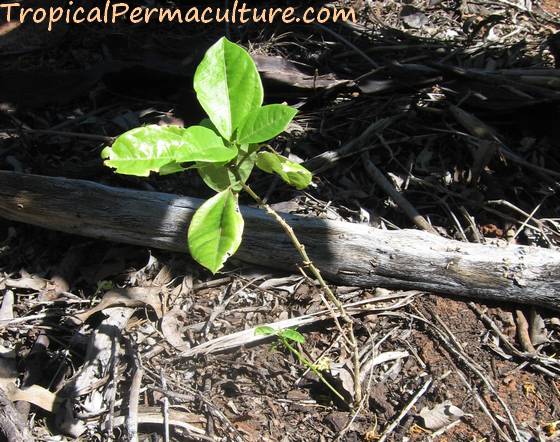 A passionfruit seedling.
A passionfruit seedling.Reasons Not To Grow Passionfruit From Seed
Seeds of hybrid varieties do not grow true to type. If you live in a cooler climate the passionfruit you buy may be a hybrid variety. If you grow that seed you don't know what kind of fruit you will get. It will be nothing like the parent plant and probably not very nice.
Find out what the fruit is that you buy, or buy the seed so you know what you are planting, or even buy a plant from a nursery.
Another reason for not growing passionfruit from seed is the high susceptibility of the purple varieties and the hybrids to the root disease Fusarium wilt. Luckily, resistant root stocks exist (flavicarpa varieties).
If Fusarium wilt is a problem in your soil, and if you need to grow susceptible varieties because of your cool climate, then you may want to invest in a grafted plant from a nursery.
Ah, it's nice to live in the true tropics. All tropical passionfruits are reasonably resistant to Fusarium wilt and they are also more resistant to nematodes, another problem when growing passionfruit.
Planting Passionfruit Vines
You can plant out your seedlings when they are about eight inches high (20 cm). If you wait too long and they are much bigger than that, prune them back as you plant them out. It helps reduce moisture loss while the root system settles in.
Make sure that whatever support you have in mind is strong enough for the vine. They do get huge and heavy pretty quickly and need something sturdy.
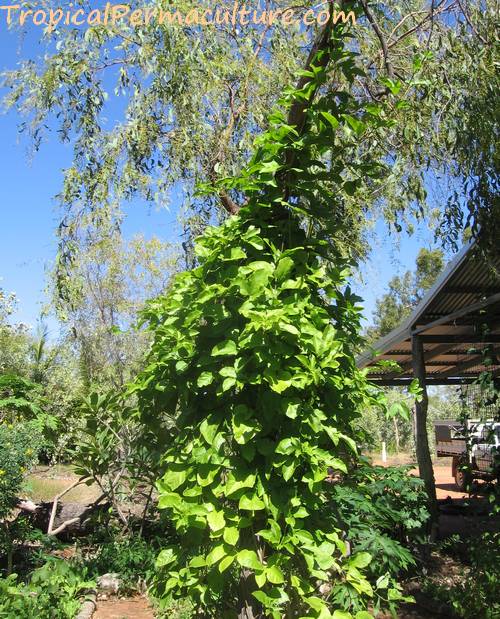 Young passionfruit vine starting to climb up a tree.
Young passionfruit vine starting to climb up a tree.
Also be aware that a vigorously growing passionfruit will climb over any- and everything it can reach and can quickly smother plants. Make your own life easier by growing passionfruit away from other shrubs and trees.
(Note to self: I should heed that advice myself.)
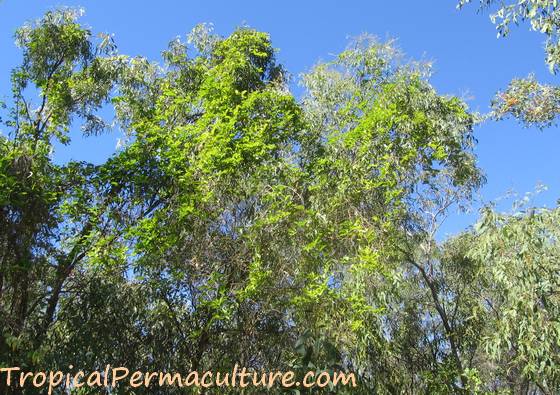 Not long after, the same passionfruit vine is climbing over several tree tops, way out of reach.
Not long after, the same passionfruit vine is climbing over several tree tops, way out of reach.
Be careful to disturb the roots as little as possible. Dig a big enough hole, at least twice as big as the root ball, and ideally mix the soil with compost before you back fill. Then mulch thickly around the plant.
In the early days you may have to train your vine up the support by carefully tying it.
But it will quickly get the message. As soon as there is something for the little tendrils to grab hold of, say the first wire on your trellis, it will climb on its own.
Feeding And Watering Passionfruit Vines
Yep, plenty of both, please.
Passionfruit needs a steady supply of both water and nutrients.
Of course, as always, don't overdo it. Overwatering can lead to root problems. Make sure you don't have water puddling or not draining away.
Overfeeding can also lead to problems. Too much nitrogen (most commercial fertilisers are heavy on nitrogen) will lead to lots of soft green leaves, attractive to all sorts of insects and diseases, but you get little fruit.
So, lots of compost, lots of mulch, and the odd sprinkle of a balanced, organic, slow release fertiliser.
Pollination Of Passionfruit
Now here is an issue that I only became aware of when readers started asking me about it.
Or rather, asking why their healthy and profusely flowering passionfruit vines did not set any fruit.
Or why the fruit was small and hollow rather than filled with delicious, juicy pulp.
There are several possible reasons for this:
- Even though the purple passionfruit is self-fruitful (meaning a flower can be pollinated with its own pollen) wind pollination does not work with passionfruit. The pollen is too sticky to be moved by wind.
Passionfruit flowers rely exclusively on bees for pollination. No bees, no fruit.
You can help your passionfruit by planting plenty of herbs and flowers in your garden that attract bees. - While purple passionfruit is self-fruitful, the yellow passionfruit is mostly self-incompatible and needs to be cross pollinated with another cultivar.
So if yours is only the passionfruit vine near and far, you need to plant a second vine of a different cultivar. - The weather! Pollination works best in warm temperatures and humid conditions. If the air is too dry, or it is too hot or too cold, and also during torrential rains, pollination will be ineffective.
Since I grow several varieties of passionfruit in my garden, I never had a problem with pollination. Sure, I did notice that there were times when I had no fruit despite having many flowers. I contributed it (correctly) to the weather/temperatures and didn't worry about it, since I knew that sooner or later I would be showered with passionfruit.
How Long Does Passionfruit Take To Fruit?
That depends on several factors. The tropical varieties fruit quicker than the purple passionfruit.
Any passionfruit will reach maturity sooner if growing in a warmer climate.
A passionfruit vine planted in spring fruits sooner than a passionfruit planted in autumn.
In ideal conditions (early spring planting in the tropics) you can get fruit within six months.
Autumn planting in a cooler climate means you may have to wait for over 12 months.
When To Harvest Passionfruit?
That's what I love best about growing passionfruit. You don't need to worry about harvesting them. When they are ready they'll drop. Dropping on the ground does not hurt them the least bit, they will neither rot nor will they get eaten by insects, birds or anything else. (Ok, possibly the neighbour's kids.)
Just collect your passionfruit as often as you feel like it.
When one of my passionfruit vines is in peak production I usually do it twice a day. My vines are very productive.
At other times I will pick up my red passionfruit daily. It has a much thinner skin and in my warm and humid climate I find it goes moldy on the inside unless I put it in the fridge straight away.
My yellow passionfruits do not mind lying on the ground in the sun for a few days, and then sitting on the kitchen bench for weeks. They shrivel up and look awful, but they are still juicy and delicious inside.
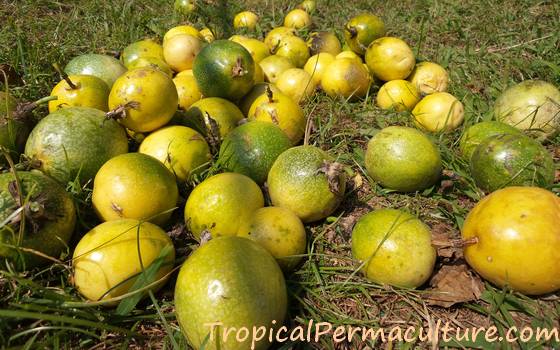
Pruning Passionfruit
Pruning passionfruit is essential.
Well, usually it is. I don't always do it. Some of my passionfruit vines raced up into some huge trees and I can't get to them. So I just let them be.
Anyway, most people grow passionfruit on much smaller structures, like fences or trellises. If you don't prune your passionfruit you end up up with a thick, tangled mess of dead wood, and a plant that has lots of problems with fungal diseases.
Don't be shy, take your cutters to it. In the tropics you can prune a passionfruit as soon as it has finished fruiting. In cooler climates prune passionfruit in early spring.
Cut out everything that is dead or weak, trim healthy branches by about a third, and even fully remove some of them. You have to keep the plant within bounds, you need to make sure that some air can circulate through the foliage, and you want to stimulate vigorous new growth. Passionfruit only sets fruit on new growth.
If your passionfruit is growing where it shouldn't, or threatening to smother other plants, you can of course trim those shoots at any time.
How Long Does A Passionfruit Vine Live?
I already mentioned it, growing passionfruit can be tricky because they are very susceptible to all sorts of root problems. Usually the plants are not all that long lived, five to seven years is a long life for a passionfruit vine.
Commercial passionfruit growers work on a life span of three years for their passionfruit vines. However, a well tended, well fed vine in a good location in healthy soil may live a lot longer.
I find that after three years the productivity of a vine definitely decreases, so I don't plan for them to live any longer than that. I simply start one or two new plants every other year. I'm lucky enough to have the space to do so.
If you don't have that space you will need to watch your passionfruit carefully, so that if you notice problems you can replant in time.
Don't be too disheartened if your healthy and productive vine after a few years suddenly dies. I'm afraid that passionfruit have a bad habit of doing just that.
If you follow permaculture design principles in your gardening methods, then your soil is improving all the time, and the next passionfruit will grow better and live longer.
To discover my secret of growing passionfruit in a supposedly impossible location, check out the page about passionfruit in permaculture designs.
